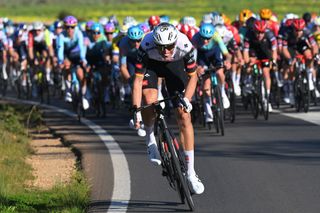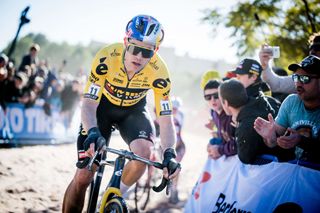Spring Classics 2025
Latest News from the Race
-
'For Belgians, it's the first real race of the season' - Thomas De Gendt on why Omloop Het Nieuwsblad matters so much
'A win in Omloop means your Classics season is already made' -
‘We will be one of the main favourites in these races’ - UAE Team Emirates-XRG confident ahead of Opening Weekend
Tadej Pogačar is absent from the first Spring Classic of the season as UAE Team Emirates-XRG announce their lineups for Omloop Het Nieuwsblad and Kuurne-Brussel-Kuurne -
'You can feel a bit of extra tension in everyone' - Wout van Aert cautious but hoping to fly at Omloop Het Nieuwsblad
Visma-Lease a Bike the team to beat at Belgian Opening Weekend
| Race (Links to race home) | Date | Winner |
|---|---|---|
| Omloop Het Nieuwsblad Women 2025 | 1 March 2025 | Lotte Claes (Bel) Arkea-B&B Hotels |
| Omloop Het Nieuwsblad 2025 | 1 March 2025 | Søren Wærenskjold (Nor) Uno-X Mobility |
| Omloop van het Hageland 2025 | 2 March 2025 | Femke Gerritse (Ned) SD Worx-Protime |
| Kuurne-Brussel-Kuurne 2025 | 2 March 2025 | Jasper Philipsen (Bel) Alpecin-Deceuninck |
| Le Samyn des Dames 2025 | 4 March 2025 | Lorena Wiebes (Ned) SD Worx-Protime |
| Le Samyn Classic 2025 | 4 March 2025 | Mathieu van der Poel (Ned) Alpecin-Deceuninck |
| Strade Bianche Women 2025 | 8 March 2025 | Demi Vollering (Ned) FDJ-SUEZ |
| Strade Bianche 2025 | 8 March 2025 | Tadej Pogačar (Slo) UAE Team Emirates-XRG |
| Ronde van Drenthe 2025 | Cancelled | Row 8 - Cell 2 |
| Nokere Koerse Women 2025 | 19 March 2025 | Row 9 - Cell 2 |
| Nokere Koerse 2025 | 19 March 2025 | Row 10 - Cell 2 |
| Milano-Torino 2025 | 19 March 2025 | Row 11 - Cell 2 |
| Grand Prix de Denain - Porte du Hainaut 2025 | 20 March 2025 | Row 12 - Cell 2 |
| Milan-San Remo 2025 | 22 March 2025 | Row 13 - Cell 2 |
| Milano-Sanremo-Donne 2025 | 22 March 2025 | Row 14 - Cell 2 |
| Trofeo Alfredo Binda - Comune di Cittiglio 2025 | 16 March 2025 | Row 15 - Cell 2 |
| Classic Brugge-De Panne Women 2025 | 27 March 2025 | Row 16 - Cell 2 |
| Classic Brugge-De Panne 2025 | 26 March 2025 | Row 17 - Cell 2 |
| E3 Saxo Classic 2025 | 28 March 2025 | Row 18 - Cell 2 |
| Gent-Wevelgem 2025 | 30 March 2025 | Row 19 - Cell 2 |
| Gent-Wevelgem Women 2025 | 30 March 2025 | Row 20 - Cell 2 |
| Dwars door Vlaanderen Women 2025 | 2 April 2025 | Row 21 - Cell 2 |
| Dwars door Vlaanderen 2025 | 2 April 2025 | Row 22 - Cell 2 |
| Tour of Flanders Women 2025 | 6 April 2025 | Row 23 - Cell 2 |
| Tour of Flanders 2025 | 6 April 2025 | Row 24 - Cell 2 |
| Scheldeprijs Women 2025 | 16 April 2025 | Row 25 - Cell 2 |
| Scheldeprijs 2025 | 9 April 2025 | Row 26 - Cell 2 |
| Amstel Gold Race 2025 | 20 April 2025 | Row 27 - Cell 2 |
| Amstel Gold Race Ladies Edition 2025 | 20 April 2025 | Row 28 - Cell 2 |
| De Brabantse Pijl Women 2025 | 18 April 2025 | Row 29 - Cell 2 |
| De Brabantse Pijl 2025 | 18 April 2025 | Row 30 - Cell 2 |
| Paris-Roubaix Femmes 2025 | 12 April 2025 | Row 31 - Cell 2 |
| Paris-Roubaix 2025 | 13 April 2025 | Row 32 - Cell 2 |
| La Flèche Wallonne Femmes 2025 | 23 April 2025 | Row 33 - Cell 2 |
| La Flèche Wallonne 2025 | 23 April 2025 | Row 34 - Cell 2 |
| Liège-Bastogne-Liège 2025 | 27 April 2025 | Row 35 - Cell 2 |
| Liège-Bastogne-Liège Femmes 2025 | 27 April 2025 | Row 36 - Cell 2 |
The Spring Classics mark the thaw of winter and the end to training rides, coffee stops and team presentations as riders start to dig into the meat of the 2025 season.
The opening weekend is not the first race day of the year but the start of the traditional Belgian Classics, with Omloop Het Nieuwsblad and Kuurne-Brussel-Kuurne for men and Omloop van het Hageland for women.
Strade Bianche is the next major race after the intervening Ename Samyn Classic (formerly Le Samyn) and Le Samyn des Dames and typically provides warmer, more pleasant racing conditions in which to tackle the unique challenge of racing over the 'white roads' of Tuscany.
The Women's WorldTour lost a round in 2025, with the cancellation of the Ronde van Drenthe, which featured the famous steep VAM Berg climb.
That makes Nokere Koerse the next Spring Classic for men and women - a race that is based around the cobbled Nokereberg climb. However, organisers deemed the old approach to be too dangerous, so they've moved the finish to the opposite direction.
Milano-Torino was added to the spring calendar in 2022. It used to take place in the autumn but now leads up to Milan-San Remo and uses a flatter course.
An alternative to the Italian semi-classic is the GP de Denain which serves as a small taste of the cobbles of Paris-Roubaix.
The first Monument of the season, Milan-San Remo is a venerable race that dates back to 1907. Also known as La Classicissima (the big classic) and La Primavera (the spring), it is the most important day in Italian cycling.
The women get their version of the event in 2025 with the introduction of the Women's Milan-San Remo, although details were scarce in early February.
The Women's WorldTour then heads to Cittiglio for the Trofeo Alfredo Binda, which dates back to 1974.
Racing then heads back to Belgium for the Classic Brugge-De Panne. A Women's Classic Brugge-De Panne was added in 2018. Both start in Bruges before heading into the windswept swamp plains of De Moeren, before heading for the finish in De Panne. If the race hasn't been broken apart in the wind, it's a likely bunch sprint.
Another warm-up race, the E3 Saxo Classic, a mini-Tour of Flanders, is exclusively for the men. It leads into Gent-Wevelgem, another historic Flandrien Classic that uses features of Brugge-De Panne and the climbs of West Flanders, along the French border including the iconic and decisive Kemmelberg.
The men's race was first held in 1934 while the Women's Gent-Wevelgem was created in 2012 and now acts as the fifth event on the WorldTour calendar.
Dwars door Vlaanderen occupies the Wednesday before the Tour of Flanders. A Women's Dwars door Vlaanderen was established in 2012.
The week culminates with the Tour of Flanders, one of the most iconic days on the cycling calendar.

Since 2004, there has also been a women's Tour of Flanders. The courses have changed over the years but the current iteration uses circuits that include the Oude Kwaremont and super-steep Paterberg, both serving as the grand finale ahead of the 13km run-in.
The sprinters get to shine in the Scheldeprijs, known as the 'world championship for sprinters'. The race takes its name from the Schelde river up near Antwerp in the east of Flanders, and there can be a threat of wind before the races heads to Schoten for laps of a finishing circuit.
The men's race was created in 1907, while a women's Scheldeprijs was introduced in 2021.
The Hell of the North, Paris-Roubaix is the only French Classic but it is arguably the most important of the entire spring, with riders fighting across 50+ kilometres of rough cobbled roads to hoist the cobblestone trophy. The men's race was first held back in 1896, while a women's Paris-Roubaix was only introduced in 2021.
Between the cobbled and Ardennes Classics comes De Babantse Pijl, which takes place between Flanders and Wallonia. First held in 1961 and the women's Brabantse Pijl since 2016, both races feature a variety of climbs, both cobbled and paved.
The Amstel Gold Race, first held in 1966, is one of the three Ardennes Classics, even if it takes place in Limburg, the Netherlands. Named after a beer, it's a snaking and undulating ride through the hills of Limburg, with climbs like the Cauberg make for a chaotic finale.
A women's Amstel Gold Race was added in 2001 and both take place on the same day and start and finish near Valkenburg.
La Flèche Wallonne comes midweek with the annual showdown on the Mur de Huy. The men's race was first held in 1936 and the women's La Flèche Wallonne in 1998, and the winner invariably comes from a large group splintering into pieces on the steep climb in Huy.
The oldest of the Classics, Liège-Bastogne-Liège was first held in 1892. The women's Liège-Bastogne-Liège was set up by Tour de France organisers ASO in 2017.
The races start and finishes in Liège, heading south to Bastogne before returning back. A previous finale in Ans became too predictable so organisers moved the finish back to Liège.
Races
-
Spring Classics 20251 March 2025 | Various
Latest Content on the Race

'For Belgians, it's the first real race of the season' - Thomas De Gendt on why Omloop Het Nieuwsblad matters so much
By Thomas De Gendt published
Opinion 'A win in Omloop means your Classics season is already made'

‘We will be one of the main favourites in these races’ - UAE Team Emirates-XRG confident ahead of Opening Weekend
By Joseph Lycett published
News Tadej Pogačar is absent from the first Spring Classic of the season as UAE Team Emirates-XRG announce their lineups for Omloop Het Nieuwsblad and Kuurne-Brussel-Kuurne
Related Features
-
'For Belgians, it's the first real race of the season' - Thomas De Gendt on why Omloop Het Nieuwsblad matters so much
'A win in Omloop means your Classics season is already made'
